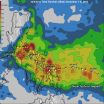NASA satellite data shows Hagupit dropped almost 19 inches of rainfall
2014-12-10
(Press-News.org) Typhoon Hagupit soaked the Philippines, and a NASA rainfall analysis indicated the storm dropped almost 19 inches in some areas. After Hagupit departed the Philippines as a tropical storm, NASA's Terra satellite passed over and captured a picture of the storm curled up like a cat waiting to pounce when it landfalls in Vietnam on Dec. 11.
The Tropical Rainfall Measuring Mission or TRMM satellite, managed by NASA and the Japan Aerospace Exploration Agency gathered over a week of rainfall data on Hagupit. That rainfall data along with data from other satellites was compiled into an analysis to determine how much rain fell over various areas of the Philippines and surrounding areas.
On Dec. 8, the TRMM team at NASA's Goddard Space Flight Center in Greenbelt, Maryland performed a preliminary rainfall analysis and updated it on Dec. 9. The analysis of rainfall from Dec. 1-9, 2014) showed rainfall totals of over 450 mm (17.5 inches) in a few areas in the eastern Philippines near where Hagupit came ashore. Even greater rainfall totals of over 477 mm (18.7 inches) were analyzed over the open waters of the Philippine Sea east of Manila.
Manila received moderate to heavy rainfall but avoided extremely heavy precipitation as Hagupit (Ruby) moved past to the south of the capital. Rainfall amounts of over 200mm (almost 8 inches) were prevalent from southern Luzon through eastern Samar.
On Dec. 10 at 03:10 UTC (Dec. 9 at 10:10 p.m. EST), NASA's Terra satellite captured a view of Tropical Storm Hagupit in the South China Sea. In the visible image, Hagupit appeared to be curled up as thunderstorms surrounded the center, and extended in a wide band to the northeast of the center. Hagupit's center was almost in the middle of the South China Sea between the Philippines to the east and Vietnam to the west.
At 1500 UTC (10 a.m. EST), Hagupit's maximum sustained winds remained at 40 knots (46 mph/74 kph), the same strength they were on Dec. 9. Hagupit was centered near 13.6 north longitude and 114.7 east latitude, or about 533 nautical miles (613.4 miles/987.1 km) east-northeast of Ho Chi Minh City, Vietnam. The storm was moving to the west at 9 knots (10.3 mph/16.6 kph).
Hagupit is now predicted by the Joint Typhoon Warning Center to continue weakening and make landfall in southern Vietnam mid-day Dec. 11 (EST) or just after midnight local time in Vietnam. A Severe Tropical Storm Warning is currently in effect for southern Vietnam.
INFORMATION:
For the latest forecasts and warnings from the Vietnam National Centre for Hydro-meteorological forecasting, visit:
http://www.nchmf.gov.vn/Web/en-US/104/102/24189/Default.aspx
Rob Gutro
NASA's Goddard Space Flight Center
[Attachments] See images for this press release:


ELSE PRESS RELEASES FROM THIS DATE:
2014-12-10
COLUMBIA, Mo. - Previous cancer research has revealed that women are less likely than men to suffer from non-sex specific cancers such as cancer of the colon, pancreas and stomach. Scientists theorized that perhaps this trend was due to a protecting effect created by female hormones, such as estrogen, that help prevent tumors from forming. Now, researchers at the University of Missouri have found evidence suggesting that the male hormone testosterone may actually be a contributing factor in the formation of colon cancer tumors.
In his study, James Amos-Landgraf, an assistant ...
2014-12-10
Ants: Ever since agriculture evolved ca 10.000 years ago, plants have been artificially selected to become the fast growing and highly productive varieties we know today. However, humans were not the first to see merit in cultivating their own food, as ants have been doing this for 50 million years. A lineage of South-American ants collect leaves and recycle their own feces to manure a fungus garden for food. New research shows that these ants have an evolutionary history of improvement of their fungal crops.
A joint effort by researchers at the Universities of Copenhagen ...
2014-12-10
ANN ARBOR, Mich. - Urinary tract infections can occur with no apparent cause, and as effectiveness of antibiotics fades, treating them is also becoming less predictable.
University of Michigan Medical School researchers have identified bacterial genes that help the infections spread, providing a potential new target for treating UTIs, a global public health concern mostly affecting women. UTIs lead to lost work time, emergency room visits and health care spending of $3.5 billion in the United States.
The research findings, published in this week's Proceedings of the ...
2014-12-10
A new study by Robert Stahelin, an adjunct associate professor of chemistry and biochemistry at the University of Notre Dame and an associate professor at the Indiana University School of Medicine-South Bend, as well as a member of Notre Dame's Eck Institute for Global Health, investigates how the most abundant protein that composes the Ebola virus, VP 40, mediates replication of a new viral particle.
"In brief, the Ebola virus has just seven proteins that encode in its genome," Stahelin said. "VP40 is critical to the formation of a new viral particle and it does this ...
2014-12-10
Ads can communicate their main message in as little as a tenth of a second, helped by color, according to a new study published in Marketing Science, a publication of the Institute for Operations Research and the Management Sciences (INFORMS).
The Buffer Effect: The Role of Color When Advertising Exposures Are Brief and Blurred is by Michel Wedel, Pepsico Chaired Professor of Marketing at the Robert H. Smith School of Business of the University of Maryland and Rik Pieters, Professor of Marketing at the Tilburg School of Economics and Management of the University of Tilburg ...
2014-12-10
A sex-changing fish called California sheephead (Semicossyphus pulcher) plays a vital role in the food web of kelp forests along the Pacific coast. Commonly found in the waters from Baja California to Point Conception -- although they can sometimes be found as far north as Monterey Bay -- sheephead feed on sea urchins, whose grazing habits can wreak havoc on community composition in kelp forests.
A new study by UC Santa Barbara research biologist Jenn Caselle uses data from three decades of research to document differential exploitation and recovery of sheephead populations ...
2014-12-10
Recent research from the University of Alberta reveals that contrary to current scientific knowledge, there's no atmospheric lead pollution in the province's oil sands region.
William Shotyk, a soil and water scientist who specializes in heavy metal pollution, examined sphagnum moss from 21 separate peat bogs in three locations around the oil sands area, near open pit mines and processing facilities.
After measuring the heavy metal content in the moss samples in his ultra-clean lab at the University of Alberta, Shotyk, based in the Faculty of Agricultural, Life and ...
2014-12-10
A University of Colorado Cancer Center study being presented at the San Antonio Breast Cancer Symposium shows that triple negative breast cancer cells process tryptophan to promote survival while traveling through the body in order to seed new tumor sites.
"I'm not saying that people with metastatic breast cancer shouldn't eat turkey during the holidays, but triple-negative breast cancer appears to have found a way to process tryptophan more quickly, equipping cancer cells to survive while in circulation, which allows them to metastasize," says Thomas Rogers, the paper's ...
2014-12-10
DALLAS - Dec. 10, 2014 - UT Southwestern Medical Center microbiologists have identified key bacteria in the gut whose resources are hijacked to spread harmful foodborne E. coli infections and other intestinal illnesses.
Though many E. coli bacteria are harmless and critical to gut health, some E. coli species are harmful and can be spread through contaminated food and water, causing diarrhea and other intestinal illnesses. Among them is enterohemorrhagic E. coli or EHEC, one of the most common foodborne pathogens linked with outbreaks featured in the news, including ...
2014-12-10
An anomaly spotted at the Large Hadron Collider has prompted scientists to reconsider a mathematical description of the underlying physics. By considering two forces that are distinct in everyday life but unified under extreme conditions like those within the collider and just after the birth of the universe, they have simplified one description of the interactions of elementary particles. Their new version makes specific predictions about events that future experiments at the LHC and other colliders should observe and could help to reveal "new physics," particles or processes ...
LAST 30 PRESS RELEASES:
[Press-News.org] NASA satellite data shows Hagupit dropped almost 19 inches of rainfall



